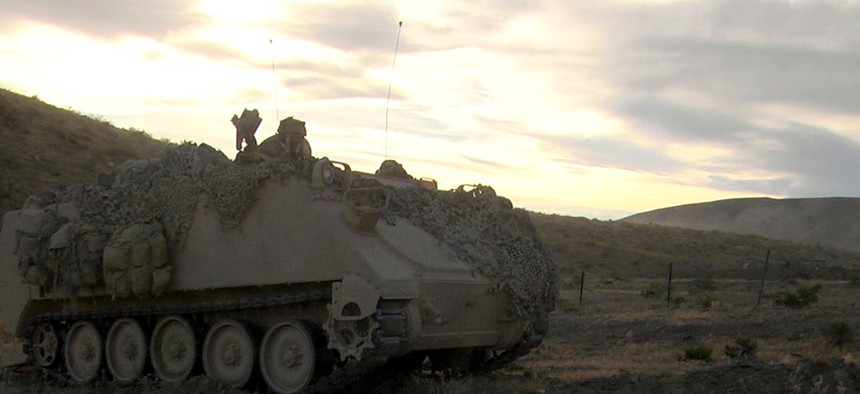
Soldiers with 1st Battalion, 155th Infantry Regiment, Mississippi Army National Guard, provide overwatch in an M113 armored personnel carrier during the battalion’s live fire exercise June 8, 2017, at the National Training Center. Mississippi National Guard photo by Spc. Jovi Prevot, 102d Public Affairs Detachment
U.S. Army Now Holding Drills With Ground Robots That Shoot
Last year saw a historic first: an exercise in which an unmanned vehicle provided live covering fire for American troops.
In a historic first, the Army conducted a live fire exercise with a remote-controlled ground combat vehicle armed with a .50-caliber machine gun. It plans to conduct more exercises with more heavily armed ground robots within the next couple of years.
The demonstration was part of the annual Northern Strike exercise, which took place last July and August at Michigan’s Camp Grayling. Primarily geared toward reserve units, this year’s event debuted an unmanned, heavily armed M113 armored personnel carrier. The driver and the weapons operator followed behind in a slightly larger M577 command post vehicle.
“The scenario here was a complex breach in a minefield,” Paul Rogers, director of the Army’s Tank Automotive Research Development and Engineering Center, or TARDEC, said at the AUVSI conference on Wednesday. “You had engineer platoons with infantry support going in and putting in bangalore torpedos ,” long tubes of explosives used to clear mines, he said. The remotely piloted M113 provided suppressive fire as the engineers worked.
It’s the first time that the Army has conducted an exercise with a ground robot providing fire. It won’t be the last. Army leaders have asked for more exercises with bigger guns, said Rogers. “We’re figuring out the details of what leadership expects and what we can deliver.” (For more on the Army’s plans for unmanned and autonomous robots, check the strategy they published last year .)
The exercise is an important step in understanding how humans and machines will fight together in close quarters, where fields of fire aren’t always clear as they are for a Reaper drone overhead.
Although it’s the first U.S. Army exercise to pair humans and shooting ground robots, it’s not the first time an armed robot was sent out to work next to troops. Shortly after the U.S. invaded Iraq in 2003, troops deployed a mini-tank bot called the SWORDS (short for Special Weapons Observation Reconnaissance Detection System) from weapons maker Foster Miller. By 2007, it was out hunting in the streets, armed with an M249 machine gun. SWORDS was effectively grounded after a series of incidents in which it began to behave unpredictably, swinging its gun in chaotic directions, according to an account of one of the incidents.
Since then, a few armed robots have rolled across the planes of Iraq and Syria. In 2016, two brothers debuted an armed, remotely-control tank bot to take on ISIS. That same year, Russia, too, began to claim that its mini-tank robots were scoring big wins with the Syrian Army. When third-party observers looked at the Russian claims, however, they found that not some of the statements did not add up .
Regardless of how well these garage projects actually perform against ISIS fighters, there’s a big incentive for weapons makers to test them in combat as soon as possible. On the one hand, it helps with marketing the bot. But on a more fundamental level, there’s no substitute for real fighting.
“Look at all the learning that happened during the Afghanistan war, the Iraq war,” said Rogers, referring to how the United States improved its use of unmanned aerial drones in those conflicts. “When you’re in that, the learning is exponential.”
Rogers couldn’t say when the United States will start deploying armed ground robots. It depends on when the machines can be tested and how well they perform. “We are on that path of exploration. It’s experiment, test, feedback, [address] concerns, challenges and limitations. You go through an iterative approach. But the faster we can turn those iterations, the better.’” Now, he says, the Army is in a phase of “constant, rolling, and evolving experimentation.”
Are armed robots safer than they were? Says Rogers: they’re as safe as anything else is… in war. But there’s more sensor data on the battlefield today from overhead drones and other sources, to help with targeting and performance, than there was in 2003. Most importantly, in keeping with Defense Department policy, humans will remain the decision-maker in terms of firing, he emphasized.
“It’s about having control measures in [and the] the appropriate intelligence. That weapon really doesn’t fire until the human that’s responsible for it, allows it. It’s detecting a target, sharing that target information, it’s getting permission to fire. The human is in control. It’s not a whole lot different than, if you are in a Bradley today and have a remotely controlled gun” on the roof of the vehicle.
But don’t expect the Army to come out with a specific mini-tank bot anytime soon. Rogers is interested in highly modifiable machines with flexible software architectures that connect well with what the Army has already. The Army’s experience with iconic ground bots like the iRobot PackBot (of Hurt Locker fame ) is over, he said. And rightly so. “We bought thousands upon thousands of small robotic systems,” he says of the robots the military bought for explosive retrieval in Iraq. ”Most of those systems have been disposed of… When we came out, we had far more than we needed, had to dispose of thousands. That can not be the standard model gong forward.”







